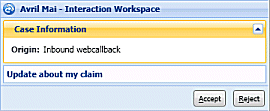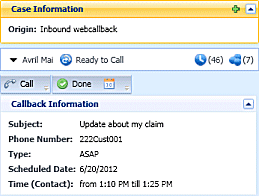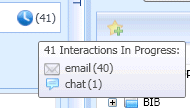Handle Web Callback Interactions
In this lesson, you will learn how to accept a web callback voice interaction by using Interaction Workspace. This lesson contains the following sections:
Receiving a Web Callback Interaction
A web callback interaction is initiated when a contact visits your company's web site and submits a request for an agent to telephone the contact at a time that the contact specifies. If you are the selected internal target for a web callback interaction, you receive a notice on your workstation desktop. You can decide to accept or reject the interaction. If you accept it (answer it), the interaction window is displayed. The interaction window contains information about the call and the controls that you need to complete the interaction. The Web Callback Interaction window is similar to the Voice Interaction window (refer to Receiving a Voice Interaction). It enables you to view all the information that is necessary to handle a web callback interaction with a contact who has requested a callback from your company web page.
Lesson: Handling a web callback interaction
- To handle a web callback voice interaction properly.
Prerequisites
- You are logged in to Interaction Workspace (see Lesson: Logging in to Interaction Workspace).
- Your status is Ready for the web callback-media channel (see Lesson: Going Ready in the Interaction Workspace Main window).
- You are the internal target for the inbound interaction.
Start
- Your hard phone or soft phone rings, and a preview of the inbound interaction is displayed on your workstation desktop in an interactive-notification view (see the Web callback Interaction Preview interactive notification figure). The Interaction Preview contains a summary of call information, including contact information and call metrics. The Interaction Preview might also contain Case Information, which is part of the case data regarding the call. The case data might include information that the contact entered in a form on your company's web page.
- You can choose to accept or reject the interaction in the Interaction Preview by performing one of the followings steps:
- Click Accept to answer the interaction.
- Click Reject to return the interaction to the queue.
- Do nothing. The interaction will timeout and be redirected.
- If you accept the interaction, the Web Callback interaction window is displayed on your desktop. The window contains Case Information, call controls, and Callback Information (see the Web Callback interaction window case and callback information figure).
Callback Information provides you with the subject of the call, the number provided by the contact, and the scheduled date and time for the call. The status of the call is Ready to Call. In this state, you can review the Case Information and the Callback Information before you connect the call to the contact. You can use the Web Callback Interaction window to do the following:
- View contact records. See Lesson: Finding and viewing an interaction in the contact database.
- View contact history. See Managing Contact History.
- Launch the Team Communicator. See Starting a Voice Conference, Transferring a Voice Call, and Blending a voice consultation with an IM consultation.
- Schedule a different callback time. See the Lesson: Scheduling a callback.
- Set a disposition code. See Disposition Codes Assigning Disposition Codes.
- Use the Notepad to add information about the interaction to the interaction history. See Managing Contact History.
- View and edit the case information for the interaction. See Managing Contact History.
- Link to a web-page from a hyperlink in the Case Information view. The case information might contain a hyperlink to enable you to view a web-page that is related to the interaction, such as customer records. Click the hyperlink in the Case Information view to open a new browser window and view the link. Place your mouse pointer over the hyperlink to preview the web page from the Case Information view. The hyperlink might be a URL or highlighted anchor text.
If there are interactions in progress for the current contact, the number of interactions is displayed beside the connection status of the interaction (see the Dynamic Contact History Matrix displaying the number and type of interactions in progress for the current contact figure). Place your mouse pointer over the icon to display the number and type of interactions in progress (except voice interactions) for the current contact.
You might be configured to be notified if there are recent interactions for the current contact; if so, the number of recent interactions is displayed beside the connection status of the interaction (see the Recent interactions matrix displaying the list of interactions with the current contact within the last day figure). Place your mouse pointer over the icon to display the number and type of recent interactions for the current contact. If you click the icon, the Contact view is opened and the History tab is displayed. Your system administrator defines the contents as interactions during the last-specified number of days.
- Click Call to connect with the contact. The call status changes to Establishing until the contact answers the call. If the call times out because the line is busy or the contact does not answer, the status returns to Ready to Call.
- If you connect with the contact successfully, the call status changes to Connected. You can do any of the following:
- Terminate the call (see Step 6).
- Put the call on hold and retrieve the call. The call status changes to On Hold, and then back to Connected when you retrieve the call.
- Use the keypad to send DTMF to the contact.
- Start a voice or IM consultation.
- Conference the call (see Starting a Voice Conference).
- Transfer the call (see Transferring a Voice Call).
- View and read standard responses (see Lesson: Using The Standard Response Library).
- For SIP-enabled agents, additional call actions are available:
- Record the call (see Lesson: Record Interactions).
- Mute and unmute the call.
- Adjust the microphone and speaker volumes.
Note: For information about how to use the functionality in the interaction window, see the Interaction Workspace 8.1 Help.
- When the interaction is complete, either you or the contact can end the call. If you want to terminate the call, click the End Call button. The call status returns to Ready to Call.
- If required by your configuration, specify a disposition code that qualifies the outcome of the interaction by selecting an outcome from the disposition code drop-down list or radio button list in the Disposition Code view (see Assigning Disposition Codes).
- Click Done.
- If the Web Callback Interaction window does not close automatically, close the Web Callback Interaction window after you have clicked Done for each of the active interactions.
- Complete your after-call work.
End
Next Steps
- Set your status to Ready. See Lesson: Going Ready in the Interaction Workspace Main window.




